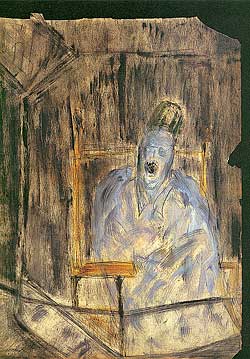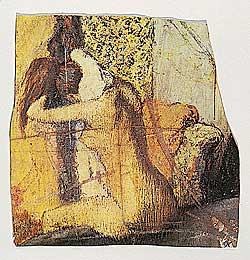 Irish-born Francis Bacon (1909-1992), possibly the greatest painter of the latter half of the twentieth century, quintessentially exemplified modern humanity’s loneliness and alienation. Indeed, Bacon is considered the greatest British painter since William Turner.
Irish-born Francis Bacon (1909-1992), possibly the greatest painter of the latter half of the twentieth century, quintessentially exemplified modern humanity’s loneliness and alienation. Indeed, Bacon is considered the greatest British painter since William Turner.
Bacon’s paintings cry out for lost values and lost greatness; for a dehumanized humanity deprived of its freedom, love, rationality; for everything the great humanist painters had celebrated in Judeo-Christian and classical tradition.
Bacon’s life illustrates that no man is an island. The influences on his lifestyle and work were multitudinous.
One in particular was his fascination with carnage and carcasses. Bacon, in fact, became fascinated with animal carcasses in butcher shops and even expressed the beauty of the carnage at automobile accidents. He translated his interest in violence to the canvas: "I think of myself as a kind of pulverizing machine into which everything I look at and feel is fed."
Bacon also used a manual on oral disease as an inspiration for his work, along with Eadweard Muybridge’s Animal Locomotion (1887). What did such books have in common? Robert Hughes in The Shock of the New (1993) writes:
Detachment: the clinical gaze on the human body as a specimen, all its privacy brushed aside. Bacon thought there was a strong analogy between the body’s various availabilities—to inspection, sex, or political coercion.
Bacon’s sources, thus, evoked different forms of abandonment. An early patron described Bacon’s "predilection for portraying people as though they were alone, unaware of any other presence."
Moreover, as Bacon commented to a friend, "the news-photograph of the thirties was his education in painting. It formalised disrespect. It wrenched the figures of authority out of their high places. It caught them unguarded and inconsequent, ‘racked by tics, their faces distorted, their clothes in disorder, their bodies off balance’."
Bacon, an atheist, faced constant torment, dissatisfaction and uncertainty, never knowing the security of a traditional religious belief. However, in a perverse way, Bacon was one of the most deeply religious painters of the century. The agony of his unbelief became so acute that the negative in his work—pessimism, loneliness, despair, emptiness, distortion, darkness, stark mortality—became an almost religious attribute. In fact, Bacon had an acute fascination with the crucifixion of Christ. "I’ve always been very moved by pictures about slaughterhouses and meat, and to me they belong very much to the whole thing," Bacon once said. "I know for religious people, for Christians, the Crucifixion has a totally different signature. But as a nonbeliever, it was just an act of man’s behavior, a way of behavior to another."
Bacon, however, clearly expressed his atheistic pessimism: "Man now realizes that he is an accident, that he is a completely futile being, that he has to play out the game without purpose, other than of his own choosing." On another occasion, he remarked: "We are born and we die and there’s nothing else. We’re just part of animal life."
Thus, Bacon, in terms of humanity and the supernatural, reached not only a position of unbelief but of despair. His paintings express modern humanity’s condition: dehumanized man dispossessed of any durable paradise.
Bacon poignantly illustrates his despair in a number of his paintings. A casual glance at his Crucifixion (1933) reveals that the stick-like limbs of a luminous and fantastic insect were superimposed by Bacon onto the crucifixion of Christ. Biographer Andrew Sinclair writes: "As he said later, he wanted his pictures to look as if a human being had passed between them like a snail, leaving a trail of slime." Despite his atheism, Bacon identified his own suffering from his homosexuality and anguish with the martyrdom of Christ.
Bacon’s Three Studies for Figures at the Base of a Crucifixion (1944) seems to depict the loss of all hope. One commentator notes: "The forcefulness with which these three Greek Furies…hurl their misery and rage at us proves the extent of his own loss of faith."
Bacon painted Three Studies under a tremendous hangover. "It’s one of those pictures," Bacon later said, "that I’ve ever been able to do under drink. I believe that the drink helped me to be a bit freer."
One art analyst noted that the "figures in the three canvases were joined in the theme of the violence that men did to one another by the power of sex and hatred. The body on the right, lying head down, suggested an inverted crucifixion by Cimabue, which Bacon thought was like ‘a worm crawling…just moving, undulating down the cross’."
Bacon’s work epitomizes the spirit of twentieth century man—a grasping for meaning and dignity within an environment of dehumanization and meaninglessness. He once said: "Nietzsche forecast our future for us—he was the Cassandra of the nineteenth century—he told us it’s all so meaningless we might as well be extraordinary."
Bacon’s human corpses (his figures of Christ hung like mutton in a butcher’s shop) showed a belief in the absolute mortality of man without hope of redemption. "Of course, we are meat," he said, "we are potential carcasses."
Bacon’s distorted and idiosyncratic images bear eloquent witness to the actual events of the post-war period and more generally to twentieth century humanity’s innate capacity for mass violence. The artist as prophet, Bacon is the extreme voice of despair in which people are totally dehumanized, blurred, decrepit banshees. Robert Hughes writes: "In his work, the image of the classical nude body is simply dismissed; it becomes, instead, a two-legged animal with the various addictions: to sex, the needle, security, or power."
While it may be true, as Bacon said, that "you only need to think about the meat on your plate" to see the general truth about mankind in his paintings, no modern artist has hammered at the twentieth century human condition with more repetitive pessimism.
 Up until recently, the public has been exposed to Bacon’s finished paintings. Now with the release of the artist’s sketches from the Joule Archive, we get a glimpse of the genius at work.
Up until recently, the public has been exposed to Bacon’s finished paintings. Now with the release of the artist’s sketches from the Joule Archive, we get a glimpse of the genius at work.
Bacon first met Barry Joule in 1978, when the two men began a friendship that would last fourteen years. In April 1992, Bacon arranged to make a trip to Spain and asked Joule to drive him to the airport. Before they set off, Bacon gave Joule a collection of material, which Joule understood to be a gift. Bacon revealed little about the gift and died a few days later in Madrid.
This amazing bundle turned out to be an old photograph album full of sketches, as well as a number of books and a collection of over 900 photographic images—many of them worked over by hand. The album’s two covers are painted with large crosses, which have given the work its current name—"The X album." The book’s inside covers feature drawings, and the 68 pages from the album held in the Joule Archive feature a further series of boldly worked oil sketches and collages, filling the front and back of the sheets. Many of the images in the album relate to Francis Bacon’s works from the ‘50s and ‘60s, and arguably, most of the album was executed toward the end of this period.
With Bacon’s Eye: Works on paper attributed to Francis Bacon from the Joule Archive (Barbican Art and 21 Publishing, 2001), we have reproductions from "The X Album." This amazing work contains images that are, by turn, erotic, beautiful and appalling—yes, typically Bacon.